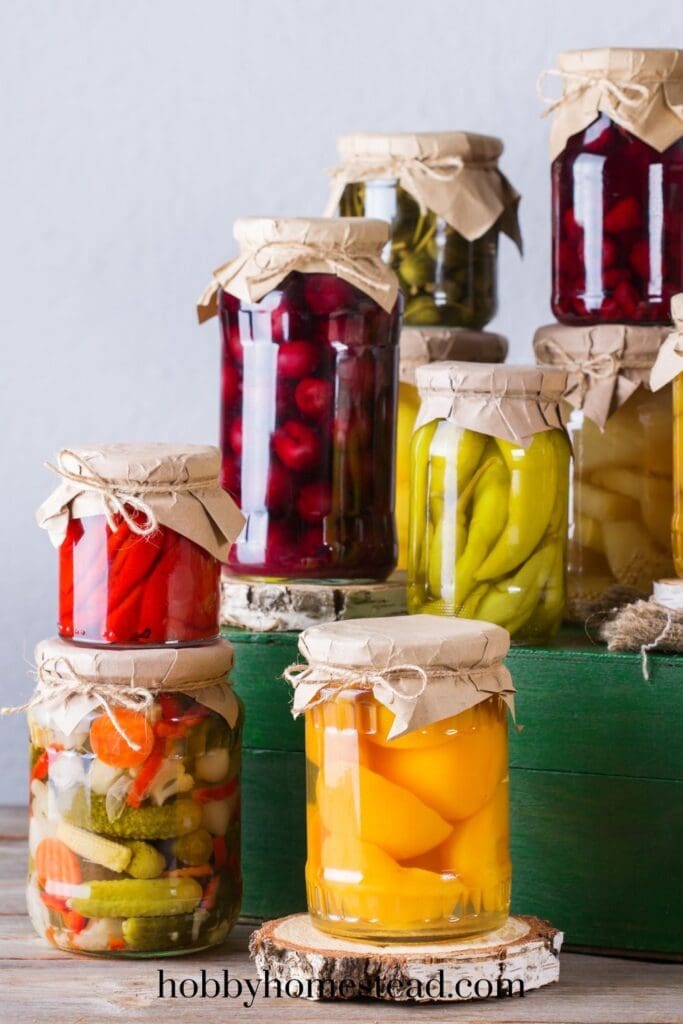Last updated on April 25th, 2025 at 10:19 am
When your budget gets tight, it makes sense to figure out what great depression life hacks would help you make ends meet. In today’s world of rising grocery costs, expensive convenience foods, and an over-reliance on store-bought counterparts, there’s something comforting and inspiring about looking back at how Depression-era folks got by with so little.
During the Great Depression era and through World War II, farm families and people in rural areas and urban areas alike developed creative ways to stretch what they had. And the best part? Many of those Depression-era life hacks are just as useful today.
Whether you’re dealing with tough times or simply want to adopt more frugal habits for financial security in the long run, these smart ideas are a great way to bring old-fashioned wisdom into your everyday life.

What Was it Like Living During the Great Depression?
Living during the Great Depression was incredibly challenging for most families, especially in rural areas and among working-class communities. Daily life was shaped by a constant need to stretch every penny, make do with what was available, and creatively problem-solve around shortages of food, money, and jobs.
Here’s a glimpse of what it was like during that time:
Financial Hardship Was the Norm
After the 1929 stock market crash, millions of people lost their jobs. Even those who kept working often saw wages slashed. Credit cards didn’t exist like they do now—if you didn’t have enough money in hand, you went without. Many families struggled to afford basic necessities like shoes, flour, or soap. It was common to barter or trade services in rural communities.
Resourcefulness Was a Way of Life
People reused and repurposed everything. Worn-out clothes became quilts, rags, or clothes for younger siblings. Old socks might be patched several times. A broken household item was fixed—not thrown away. Families learned how to stretch meals using whatever was available, often turning a whole chicken into three or four meals. Nothing was wasted—not even stale bread or leftover bones.
Meals Were Simple but Thoughtful
Convenience foods didn’t exist for most families, and even store-bought goods were considered luxuries.
Depression-era cooks used basic ingredients to create filling, frugal recipes. Beans, potatoes, bread, canned tomatoes, and garden vegetables were staples.
Fresh produce often came from backyard gardens or “thrift gardens” planted in vacant lots. A can of tomatoes or a bit of ground beef had to go a long way.
Brown bagging lunch was commonplace. Clipping coupons is a habit that remains a popular way to save today.
Strong Community and Family Ties
Families were close-knit out of necessity. Multi-generational households were common, and older kids helped care for younger siblings. Communities pulled together: neighbors helped each other with food, sewing, or repairs. Entertainment was simple and free—board games, card games, storytelling, or free movie nights at church.
A Return to the Land
Many farm families struggled due to the Dust Bowl, but those who could still grow food relied on their vegetable gardens and learned how to preserve their harvest. Victory gardens came into fashion during World War II as a patriotic way to support the war effort and feed your family. Gardening became a survival skill more than a hobby.
Simpler Living and Hard Work. Electricity usage was limited where it was even available. Shorter showers, hand-washed clothes, and using daylight hours for chores were all part of everyday life. People got by with little money, a lot of hard work, and smart, frugal habits.
Table of contents
- What Was it Like Living During the Great Depression?
- Great Depression Life Hacks That Are Still Relevant Today
- 1. Make Your Own Cleaning Products
- 2. Use Every Part of the Vegetable
- 3. Learn Basic Sewing Skills
- 4. Cook at Home with What You Have
- 5. Grow Your Own Food
- 6. Practice Frugal Entertainment
- 7. Be Resourceful with Household Items
- 8. Preserve, Create, and Stretch: Timeless Great Depression Kitchen Wisdom
- 9. Make Your Own Cleaning & Hygiene Products
- 10. Plan Smart: Batch Errands, Save Time and Money
- 11. Choose Reusable Over Disposable—Just Like They Did Back Then
Great Depression Life Hacks That Are Still Relevant Today
1. Make Your Own Cleaning Products
Buying name-brand cleaning supplies from the grocery store can add up fast, especially if you’re trying to save extra money. Depression-era cooks and homemakers knew how to make their own cleaning products with basic ingredients that served multiple purposes.
Here are a few simple fixes for your household cleaning routine:
- All-Purpose Cleaner: Mix equal parts water and white vinegar in a spray bottle. Add lemon juice or a few drops of essential oil if desired.
- Baking Soda Scrub: Combine baking soda and water into a paste. Great for scrubbing sinks, tubs, and even stovetops.
- Glass Cleaner: Mix 2 cups water, 1/4 cup vinegar, and a teaspoon of cornstarch. Shake before each use for streak-free glass.
These homemade cleaning products are not only cost-effective, but they also reduce your reliance on store-bought household products full of chemicals. Plus, they’re a good idea if you’re working toward a zero-waste lifestyle.
2. Use Every Part of the Vegetable
Food waste was not an option during the Great Depression. Every part of the vegetable was used. A frugal way to stretch their grocery bills and make the most of fresh produce from their backyard garden or thrift gardens.
- Carrot tops can be turned into a pesto or added to soups.
- Beet greens are delicious sautéed with garlic and olive oil.
- Celery leaves can be used in stocks or as a garnish.
- Potato peels can be roasted for a crispy snack.
Vegetable scraps were often saved to make flavorful broths using leftover bones or a can of tomatoes. It’s one of the best frugal living tips that still makes sense today.
3. Learn Basic Sewing Skills
In a time when many had little money for new clothes, sewing was a basic necessity. People mended worn-out clothes, patched holes, and even made new items from old clothes and fabric scraps.
- Use fabric from worn-out clothes to create quilts, potholders, or even stuffed toys for younger siblings.
- Patch jeans or jackets instead of replacing them.
- Repurpose old T-shirts into rags or reusable shopping bags.
Basic sewing skills can save a lot of money over time and are one of the best ways to reduce your dependence on fast fashion. Thrift stores and yard sales are a great place to find fabric or clothing to repurpose.
4. Cook at Home with What You Have
Frugal recipes made from basic ingredients were the foundation of Depression-era meals. Homemade meals used what was on hand—whether it was stale bread, ground beef, leftover food, or a whole chicken that could be stretched into soup, stew, and broth.
Some favorite recipes included:
- Bread Pudding to use up stale bread.
- Potato Soup made from just potatoes, onions, and water.
- Chili made with beans, a can of tomatoes, and whatever meat was available.
Today, making homemade foods from scratch is not only more nourishing but also a great way to reduce grocery costs and avoid convenience foods.

5. Grow Your Own Food
One of the most powerful money-saving tips from the Great Depression was growing your own food. Victory gardens became a way of life during World War II, and they can still help families today cut grocery shopping expenses.
- Start a vegetable garden in your yard or a herb garden on your windowsill.
- Grow your own tomato plants, lettuce, or even strawberries.
- Use a backyard garden or even containers on a balcony to grow your own produce and own fruits.
Even a small garden can yield fresh fruits and vegetables that would otherwise cost a lot of money at the grocery store.

6. Practice Frugal Entertainment
With little money to spare, Depression-era families had to find clever ways to entertain themselves at home. Simple, free activities brought people together and created lasting memories.
- Play card games or board games with the whole family.
- Host a free movie night using a borrowed DVD or streaming service.
- Tell stories or sing songs on the porch.
These are frugal tips that not only save money today but also build stronger family connections. Something money can’t buy.
7. Be Resourceful with Household Items
Depression-era folks rarely threw things away. They found creative ways to give new life to household items.
- Glass jars were reused for food storage.
- Coffee tins held buttons, nails, or sewing supplies.
- Flour sacks were transformed into dresses or aprons.
- Take shorter showers and reduce electricity usage to conserve basic necessities.
If you’re trying to save money today, reusing what you already have is a frugal way to live simply and intentionally.

8. Preserve, Create, and Stretch: Timeless Great Depression Kitchen Wisdom
The skills developed by depression-era cooks are still smart ideas in today’s world of high grocery bills and rising grocery store prices. Here’s how Great Depression life hacks helped families get by and how you can apply these useful today.
Preserve Your Garden Produce Like a Pro
In both rural areas and urban areas, families who grew their own food worked hard to preserve the fresh produce they harvested.
Tomatoes were canned or made into sauce, green beans were pickled, and fruit was turned into jam or dried for later use.
Root cellars, cold basements, and jars lined with wax were all part of the great way people stored their own food through the winter months.
This practice is making a strong comeback among younger generations today. Especially those who grow tomato plants or tend a backyard or vegetable garden.
Make Foods from Scratch—It’s Cheaper and Smarter
Instead of buying store-bought counterparts like boxed soup mixes or seasoning packets, depression-era folks made their own with basic ingredients.
A jar of homemade dry soup mix (with lentils, split peas, barley, and herbs from your herb garden) could make several meals.
Spices were stretched by combining dried onion, garlic powder, and lemon juice with salt for flavoring.
Making homemade foods and pantry staples from scratch is a frugal way to avoid the hidden costs of convenience foods. And a great way to cut down on grocery costs.
Sub Meat with Cheaper Protein Options
When enough money wasn’t available for meat, families got creative. A can of tomatoes, ground beef, or whole chicken was stretched over several meals.
Some dishes used only a small amount of meat. Just for flavor. Also, paired with cheap protein options like beans, lentils, oats, eggs, or leftover bones made into broth. These frugal recipes are still some of the best ways to save money today without sacrificing nutrition.
Use Just a Dab of Cleaning & Hygiene Products
Back then, you didn’t squirt a whole pump of dish soap or pour half a bottle of bleach into the mop bucket. Just a dab would do. One of the best frugal living tips passed down was to use less. Whether it was household items, shampoo, or laundry soap. And if you didn’t have it, you made it.
Making your own cleaning products and hygiene items was common practice. Here’s a couple of easy examples still popular among farm families and homesteaders.

9. Make Your Own Cleaning & Hygiene Products
All-Purpose Cleaner
Mix 1/2 cup white vinegar, 2 tablespoons baking soda, 1 tablespoon lemon juice, and a few drops of essential oil (optional) in a spray bottle. Great for countertops, sinks, and bathroom surfaces.
Homemade Soap
Melt down old soap scraps or use a base of lye and fat (or plant-based oil). Add dried herbs or lemon juice for scent and antibacterial properties. This frugal tip saves a lot of money on store-bought products and avoids harsh chemicals.
Deodorant Alternative
Combine cornstarch, baking soda, and a bit of coconut oil for a gentle, effective homemade deodorant.
Even personal care was simplified. Shorter showers and fewer products were a good idea for saving on water and electricity usage. It’s the kind of smart idea that pays off in the long run, both financially and environmentally.
10. Plan Smart: Batch Errands, Save Time and Money
Back in the Great Depression era, gas wasn’t cheap—even if it cost less than a dollar per gallon. Families with little money couldn’t afford to waste a trip into town. Especially for those living in rural areas, it was a common practice to plan out every stop in advance and do all errands in one go.
Doing this today is still one of the best ways to save money, time, and even mental energy on busydays. Instead of hopping in the car for a gallon of milk or a forgotten ingredient, plan a weekly or bi-weekly grocery shopping trip where you:
- Visit the grocery store
- Drop off/pick up items from the thrift shop
- Fill up on gas
- Stop by the post office or bank
- Visit the farmer’s market for fresh fruits or own produce
This intentional scheduling reduces fuel use, lowers grocery bills (less impulse buying), and leaves you with more time to cook homemade meals, mend worn-out clothes, or enjoy a free movie night or board games at home with the family.
It’s one of those frugal habits that may seem small—but goes a long way toward financial security over time. Even in urban areas, where stops are closer together, combining errands is a smart idea for reducing electricity usage, screen time, and general wear on your vehicle.
11. Choose Reusable Over Disposable—Just Like They Did Back Then
If you can don’t buy disposable products. Not because they were trying to be eco-friendly, but because they didn’t have extra money to waste on things that got thrown away. Cloth napkins, real dishes, glass jars, and metal utensils were the norm. Even old clothes were repurposed into rags, quilts, or handed down to younger siblings.
In today’s world, choosing reusable items is still one of the best frugal living tips and a clever way to save in the long run. Here are a few easy switches that reflect both frugal habits and environmental consciousness:
- Use rags instead of paper towels. Cut up worn-out clothes or thrift some cheap flannel sheets for cleaning cloths.
- Buy cloth napkins. They’re washable, long-lasting, and add charm to homemade meals.
- Bring reusable grocery bags. A great way to reduce grocery costs (some stores offer discounts!) and cut down on plastic waste.
- Use refillable containers. Store own cleaning products, homemade foods, or bulk basic ingredients in glass jars or reusable containers.
- Buy durable household items. From scrub brushes to storage containers, skip the flimsy single-use versions.
Choosing these options helps avoid store-bought counterparts that cost more over time and clutter your home with waste. Just like thrift gardens, yard sales, and mending over buying new clothes, it’s about making what you have go a long way.
Final Thoughts: Wisdom for Hard Times
In an economic downturn, whether it’s last month or next year, these frugal habits can make a real difference.
The Depression-era life hacks that helped people get through hard times are still useful today.
They teach younger generations that financial security doesn’t always come from a credit card or a trip to the grocery store, but from resilience, hard work, and smart ideas passed down through time.
These time-tested methods from a simpler era can take you a long way toward a more sustainable, affordable, and meaningful life. Whether you’re starting an herb garden, cooking your favorite recipe from scratch, or sewing your own clothes.


